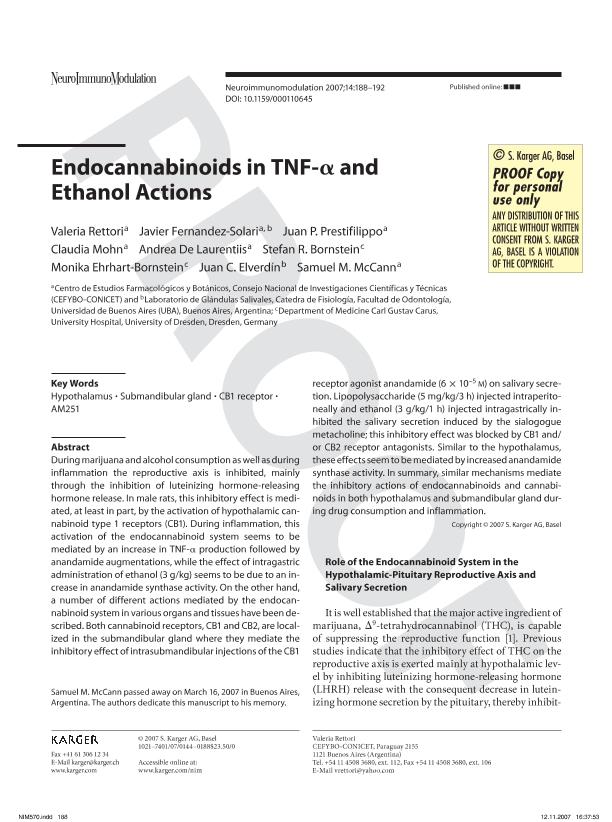Artículo
Endocannabinoids in TNF-α and ethanol actions
Besuhli, Valeria ; Fernández Solari, José Javier
; Fernández Solari, José Javier ; Prestifilippo, Juan Pablo
; Prestifilippo, Juan Pablo ; Mohn, Claudia Ester
; Mohn, Claudia Ester ; de Laurentiis, Andrea
; de Laurentiis, Andrea ; Bornstein, Stefan R.; Ehrhart Bornstein, Monika; Elverdín, Juan Carlos; McCann Samuel M.
; Bornstein, Stefan R.; Ehrhart Bornstein, Monika; Elverdín, Juan Carlos; McCann Samuel M.
 ; Fernández Solari, José Javier
; Fernández Solari, José Javier ; Prestifilippo, Juan Pablo
; Prestifilippo, Juan Pablo ; Mohn, Claudia Ester
; Mohn, Claudia Ester ; de Laurentiis, Andrea
; de Laurentiis, Andrea ; Bornstein, Stefan R.; Ehrhart Bornstein, Monika; Elverdín, Juan Carlos; McCann Samuel M.
; Bornstein, Stefan R.; Ehrhart Bornstein, Monika; Elverdín, Juan Carlos; McCann Samuel M.
Fecha de publicación:
12/2007
Editorial:
Karger
Revista:
Neuroimmunomodulation
ISSN:
1021-7401
Idioma:
Inglés
Tipo de recurso:
Artículo publicado
Clasificación temática:
Resumen
During marijuana and alcohol consumption as well as during inflammation the reproductive axis is inhibited, mainly through the inhibition of luteinizing hormone-releasing hormone release. In male rats, this inhibitory effect is mediated, at least in part, by the activation of hypothalamic cannabinoid type 1 receptors (CB1). During inflammation, this activation of the endocannabinoid system seems to be mediated by an increase in TNF-α production followed by anandamide augmentations, similarly the effect of intragastric administration of ethanol (3 g/kg) seems to be due to an increase in anandamide. On the other hand, a number of different actions mediated by the endocannabinoid system in various organs and tissues have been described. Both cannabinoid receptors, CB1 and CB2, are localized in the submandibular gland where they mediate the inhibitory effect of intrasubmandibular injections of the endocannabinoid anandamide (6 × 10–5M) on salivary secretion. Lipopolysaccharide (5 mg/kg/3 h) injected intraperitoneally and ethanol (3 g/kg/1 h) injected intragastrically inhibited the salivary secretion induced by the sialogogue metacholine; this inhibitory effect was blocked by CB1 and/or CB2 receptor antagonists. Similar to the hypothalamus, these effects seem to be mediated by increased anandamide. In summary, similar mechanisms mediate the inhibitory actions of endocannabinoids and cannabinoids in both hypothalamus and submandibular gland during drug consumption and inflammation.
Palabras clave:
Hypothalamus
,
Submandibular Gland
,
Cb1 Receptor
,
Am251
Archivos asociados
Licencia
Identificadores
Colecciones
Articulos(CEFYBO)
Articulos de CENTRO DE ESTUDIOS FARMACOLOGICOS Y BOTANICOS
Articulos de CENTRO DE ESTUDIOS FARMACOLOGICOS Y BOTANICOS
Citación
Besuhli, Valeria; Fernández Solari, José Javier; Prestifilippo, Juan Pablo; Mohn, Claudia Ester; de Laurentiis, Andrea; et al.; Endocannabinoids in TNF-α and ethanol actions; Karger; Neuroimmunomodulation; 14; 3-4; 12-2007; 188-192
Compartir
Altmétricas



